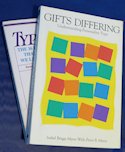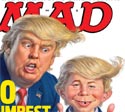
- About the MBTI
- Verify Your MBTI Type
- Personality Patterns
- MBTI Articles & Resources
- Article Directory for Educators & Students
- Books on Personality Types
- Emotional Intelligence & Personality Type
- Career Planning & MBTI
- MBTI Business Applications
- Lenore Thomson - Carl Jung Personality Type
- Site Map - Master Directory of All Articles
- MBTI Consultant Links
- Personality Type Workshops & Conferences
- Links to Other Type Websites
- Murder Mystery Business Theatre
- About Us
The Hidden Letters in the Myers-Briggs MBTI ® Type
What the four letter Personality Type doesn't tell
|
This article might be sub-titled "Do Thinking Types have Feeling?" or its corrolary "Are Feeling Types Logical?"
Of the 8 psychological preferences that all types possess to varying degrees, only 4 of them are represented by the letters identifying a particular personality type. These missing letters can lead to some unfortunate stereotyping as my suggested subtitle implied. This occurs across all of the preferences. Forgetting that Introverts also have an Extraverted nature, that Sensing preference people have no Intuitive nature, etc.
An example of this sort of confusion occured during a break at a workshop I recently attended. Jeanie a friend of mine, who has long identified herself as an INFP type, recently asked me to help explain a curiosity: "I've never understood why as a "P" there is something about organizing that both appeals to me (organizing stuff I care about) and annoys me (other stuff). My daughter is an INFJ so her interest in organizing things makes sense and I am quite confident I'm not a "J" so my organizing interests and talents seem not to fit my type."
Jeanie was perplexed by another apparent paradox: "I know I'm an 'N' and I'm supposed to extravert that mental function and according to what I read I am supposed to be attracted to lots of ideas. But I find doing that is just too overwhelming; I feel overloaded and crave simplicity. Besides if I read about or otherwise get exposed to too many ideas I end up thinking about what I could do with them and then I just get a longer to-do list and more frustrated."
So Jeanne has learned that in order to relax and enjoy her daily life she needs to protect herself from over-exposure to what her "intuition" is naturally attracted to.
Type Letters Quite Similar but also Quite Different Mental Center
While INFP and INFJ are both "NF" types their core motivation, the centerpiece of their personalities, are quite different. The dominant mental function of an INFP is Introverted Feeling, whereas INFJs dominant mental function is Introverted Intuition.
An INFP who has introverted Feeling at his or her core will seek harmony with others and harmony within. In her description of the two personality types whose dominant mental function is Introverted Feeling (INFP & ISFP) Danielle Poirier indicates they ". . . strive to find happiness, balance and wholeness for themselves . . ."
On the other hand INFJ types having introverted Intuition at their core typically reflect on "patterns, relationships, symbols, meanings, and perspectives and strive to understand the essence of things or people" (see 16-personality-types2.html ).
INFP and INFJ, although similar in letters, have two different kinds of engines driving their being.
The two types also have a different outer world orientation which is reflected by the 4th letter in the type code J or P.
J and P Personality Types - the last letter in the 4 letter type code
In Personality Typology we find generalities about J types (those who use their judgment function with the outside world), like INFJ, that they are adept at ordering, organizing, structuring, directing, etc. J's or Judgers typically are driven to seek closure and completeness.
We also find generalities about P types (those who use their perception with the outside world), like INFP, are adept at keeping open agendas, adapting, exploring, experiencing, etc. P's or Perceivers seek openness and are comfortable with incompleteness.
As generalities about J's and P's these descriptions are reasonably accurate.
The diagrams below depict a pair of INF types: one a P and one a J. While they share 3 type letters when you look at the diagrams below and note which mental function is at the core, the engine of each of the two types we've been discussing, you'll see INFJ types are not as Judging as the last letter suggests. INFJs are actually Perceiving types because Intuition, a perceiving function, is their dominant.
And INFP types are actually Judging types because Feeling, a judging function, is their dominant. So while in general INFPs might appear more adaptable and be open and exploring, on the inside they are oriented towards Judging - making decisions, sorting things out, controlling, and protecting.
This apparent conundrum is true only for the Introverted Personality Types because Introverts typically hide their dominant mental process.
So all introverted "P" types are actually closet "Js" and all introverted "J" types are actually closet "Ps." So with introverted personality types, what you "see" is not always what you "get."


Left hand portion of the circle shows the Introverted nature; right hand portion the Extraverted nature. Shaded portion indicates dominant attitude of the MBTI Type.
![]()
But Wait there's more - The Hidden Letters not shown by the type code
INFP & Extraverted Thinking
In the case I cited at the outset of this article, there is another factor that helps explain why my INFP friend seems to like organizing things. It is one of the hidden letters in her type code: Thinking. For an INFP this is extraverted Thinking. In my descriptions of the Jung-Myers mental functions I indicate that extraverted Thinking's focus is order, organizing and ordering things in the outside world. Because extraverted Thinking is in the inferior (or 4th) mental function in an INFP, this mental process part of Jeanie's unconscious mind, in essence operating in a fashion most hidden to herself. (But since it is extraverted it is more likely to be noticed by others).
This ordering and organizing drive of her unconscious "T powers" may not operate across the board in the to the same extent of those for whom extraverted Thinking is their dominant mental function. Jeanie may only use it in situations involving helping people or causes that she cares about. Her introverted Feeling, her driving mental process running the show, may give directions to that extraverted Thinking - organize this, do this, do that - because "you care about this person" or "this is important to your values." Unlike an ENTJ who often have this compulsion to order and organize almost everything, her drive to organize and order may be reserved for people and values she cares deeply about.
INFJ & Extraverted Sensing
Because Intution is at the core of INFJ, the ideas and understandings created in the inner mind of an INFJ are often rich in complexity, having nuances not appreciated by many other types. In their "minds eye" they see things others miss. Yet having a Judging style relating to the outside world means they like to organize things and people. The combination of a clear vision of things in the minds eye plus a penchant for action and organization can be a powerful one, two punch. As I indicated earlier, this faculty is one reason why Julie finds she always seems to be the one to turn ideas into action.
But when it comes to organizing activities and events, it isn't just the "J" letter of the code that explains this talent. It is one of the hidden type letters of INFJ, extraverted Sensing, that drives this process. Although the description being "detail-oriented" is inaccurate because this type's main driver is introverted Intuition (see Danielle's descriptions of INFJ and INTJ), their unconscious extraverted Sensing can cause them to focus on and attend to here-and-now details of whatever program or endeavor they are committed to.
Extraverted Sensing is an unconscious function for an INFJ and it isn't as developed as it would be by a person whose dominant process is extraverted Sensing. Being not fully developed nor fully under conscious control can lead an INFJ into tunnel vision - seeing and emphasizing certain details - but completely overlooking others.
The Missing Letters Play a Role in All 16 Personality Types
The type face diagrams I use to depict each personality type illustrates the pattern played by all four Jung-Myers function and attitude pairs: E-I, S-N, T-F, J-P.
Example: INFP and ENFP Type Face Diagrams


Left hand portion of the circle shows the Introverted nature; right hand portion the Extraverted nature.
Shaded portion indicates dominant attitude of the MBTI Type.
Judging Functions: Thinking (T) and Feeling (F) Perceiving Functions: Sensing (S) and Intuition (N)
Attitude or Orientation: Introverted (I) and Extraverted (E)
You can see by the diagrams that INFP, although an Introverted Type, does have an Extraverted Face. Since the primary function this type shows to the outside world is a Perceiving function (N - Intuition) P is the fourth letter for this type's 4 letter code. But as we observed earlier the dominant introverted function is Feeling, which is Judging function, so in reality an INFP is a Judging Type since that is her dominant mental function. The diagram also shows how the hidden letters of S and T come into play.
ENFP shows its dominant face to the outside world. What you see is what you get. Like INFP the primary function this type shows to the outside world is a Perceiving function (N - Intuition) so P is the fourth letter for this type's 4 letter code indicating their outside world perspective. But unlike INFP, the extraverted Intuition is also this type's dominant mental function. So ENFP is a Perceiving Type - both in terms of the outside world perspective and its dominant mental function. The hidden letters S and T are employed in a manner similar to an INFP; however the influence of extraverted Thinking is likely to be a more apparent to others and may be more consciously exercised by an ENFP (whereas in INFP it is more subtle and hidden to the INFP).
In the Type Face diagrams, the two letters in the smallest fonts - the hidden mental functions - are usually exercised in an unconscious or semi-conscious manner. The smallest being the least conscious and most likely the least developed of the four mental functions shown in the diagram.
But wait there's more. That tiniest letter in its attitude (this would be the extraverted T for the INFP and the introverted S for the ENFP) really isn't the most buried and least conscious/least developed of all. It is that fourth function in the same attitude of the dominant function that is the true blind spot and achilles heal of the type. This would be introverted Thinking for the INFP and extraverted Sensing for the ENFP. Each of these are the true polar opposites of their dominant function in their attitude. Examples.
INFPs cup of tea is her introverted Feeling; her blind spot is her introverted Thinking. Asking an INFP to "think logically" in terms of her internal guidance system is saying abandon the most important part of you (your Introverted Feeling) to use a part of yourself that feels foreign and uncomfortable and is simply not you.
An INFP actually works better with Thinking when doing it in the external world - perhaps talking things out with a friend. In this external sphere there isn't an inherent conflict with introverted Feeling.
ENFPs cup of tea is his extraverted Intuition; his blind spot is his extraverted Sensing. Asking an ENFP to accurately attend to many details in the external world is futile. It is saying put aside the most valuable part of you - your Extraverted Intuition - so you can operate on your least experienced and least conscious part of yourself - your extraverted Sensing.
The analogy for this is try to breathe out and breathe in at the same time - doesn't work. Gotta do one or the other.
So this rule of thumb is true of all types:
Whatever is a person's dominant function used in the preferred attitude (I or E) its opposite mental function in that same attitude (I or E) is most likely that person's achilles heal - the process they have the most difficulty using effectively.
Conversely that mental process that is opposite their dominant is best used in the opposite attitude where it does not conflict with and compete for energy with one's dominant mental function. If Fe runs the show, then Ti can help balance it; if Se, then Ni; if Ni, then Se, etc. This is part of the Yin-Yang of personality type - the balancing of opposites into a whole.
 Next: THE TYPE FACE DIAGRAMS of all 16 types - THE PATTERNS OF PERSONALITY TYPE
Next: THE TYPE FACE DIAGRAMS of all 16 types - THE PATTERNS OF PERSONALITY TYPE
Other Popular or New Articles on Personality Type
![]() Mobile Friendly Version of our Free Personality Type Test
Mobile Friendly Version of our Free Personality Type Test
The Civil War between Feeling and Thinking

Trump - The Mouth that Roared Once Too Often?

® MBTI, Myers-Briggs, Meyers Briggs, and Myers-Briggs Type Indicator are registered trademarks or trademarks of the Myers-Briggs Type Indicator Trust in the United States and other countries (aka meyer briggs or myers briggs or briggs myers).
Return to MBTI & Myers Briggs Personality Types Home Page
© Published by Ross Reinhold & Reinhold Development 1997 - 2023
Privacy Policy About Us




